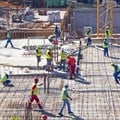There are indeed some green shoots in the local construction industry, despite the dire predictions that the sector is facing imminent collapse.

Bongani Dladla, CEO of the CIDB
2023 will be a consequential year of recovery after the industry was hit by successive waves of adversity in recent times – a universal pandemic, a sharp economic downturn, ongoing energy woes, and a regional conflict which threatens to deliver long-term, global consequences.
Construction is often a bellwether indicator of the health of the broader economy, even though it currently accounts for approximately 3% of gross domestic product. If there is an uptick in construction activity, it may well lead to a recovery in other sectors such as manufacturing, retail, and technology.
Upward movement in construction activity
Several recently published reports conclude that there is an upward movement in construction activity which may have a ripple effect on the broader sector, including emerging contractors, Black-owned and women-owned enterprises.
The SA Construction Market Report, published by Construct Africa projects that the industry will stabilise at an annual average growth rate of 3% from 2023 to 2026. This will, predominantly, be on the back of expected major investment flowing from government’s R2.3tn infrastructure plan and the benefits flowing from the Economic Reconstruction and Recovery Plan.
The bulk of this spending will go towards catalytic public infrastructure projects in the fields of energy, transport, housing, and digital infrastructure. A construction project pipeline to the value of R340bn has already been announced.
The Afrimat Construction Index, published in September 2022, is also cautiously optimistic. It reports that, the construction sector increased the value added to the economy by 4.1% in real terms in the second quarter of the year.
This was achieved despite the negative impact of events such as load shedding, the floods in KwaZulu-Natal and a sharply higher fuel price. It notes increases in both the volume and value of construction material – leading indicators of future construction activities, and an increase in employment, which is expected to accelerate once the infrastructure activities gather momentum.
Mohau Mphomela 31 Oct 2022 Improved industry sentiment
The findings of the two external reports match that of the Construction Industry Development Board’s (CIDB) own research conducted in partnership with the Bureau for Economic Research. Our most recent Small and Medium Enterprises (SME) Business Conditions Survey reflects an improved sentiment within the industry and an optimism that the coming period will deliver higher levels of construction activities and growths in profitability.
These are important indicators for the CIDB which plays a pivotal role in the sector as a regulator, facilitator and catalyst for development and transformation. We have a vision of a construction sector that is inclusive, ethical and a primary contributor to a prosperous economy.
Although we have a broad interest in the entire industry, the CIDB’s primary focus has traditionally been construction activity in the public sector which is highly dependent on government’s investment in infrastructure – new roads, bridges, dams, schools, clinics, government buildings, and housing projects.
Robert Futter and Andy Tant 26 Oct 2022 Public sector underspending
One of the biggest concerns raised in most reports and surveys pertains to underspending by infrastructure client departments, at national, provincial, and metro levels, as well as within state-owned companies.
It is of critical importance that the public sector improves its capacity to manage infrastructure projects under its control and address the lingering concerns within the industry about delays in the awarding of contracts, tardiness in implementation and late payments of contractors.
It is also imperative that emerging contractors benefit from an upswing in construction activities. Public sector spending in the sector must create opportunities for new players to participate in major activities, improve their grading, and gain vital experience which will enable them to become eligible for future projects, service delivery and employment. Focus should not only be on the public sector. The new direction is to also include the private sector.
Broad-scale participation
The entire spectrum of the construction sector must benefit from the anticipated investment in public infrastructure. Participation must be broadened to include emerging contractors – especially Black-owned and female-owned enterprises – and attract a new generation of entrepreneurs to the sector.
The nature of construction has undergone rapid and irreversible changes in recent years. The adoption of new technologies in fields such as automation, modular construction and artificial intelligence has changed the future shape of the sector.
Care should be taken that such technologies are readily accessible to smaller participants in the industry and not lead to a widening of the gulf between dominant players in the market and emerging contractors.
Closing the skills gap
Moreover, the focus must remain on training and skills development. There is an urgent need to close the gap between the skills that South Africans have, and the skills that our economy needs.
This is where the CIDB can play a critical role at the interface between the public sector, the broader construction industry, and the growing number of emerging contractors who want to help build a futuristic South Africa.











































